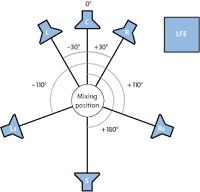SOUND FOR FILM
From Mute to Dolby Atmos™
Part 3 - Beyond 5.1
5.1 is still today’s most common sound format for cinema.
But the quest for improvement didn’t stop.
In 1993, Sony™ launched the SSDS, Sony Dynamic Digital Sound format, for Shwarzenegger‘s “Last Action
Hero”. It has 2 extra channels behind the screen: Left-Center and Right-Center.
It was the first 7.1 format on the market.
In 1999, with the new “Star Wars”, Dolby™ released the Dolby™ Digital EX,
6.1 channel with a decoding matrix to add an extra surround channel.
So, where do we need more channels? At the front or at the back? Who will
win?
In my opinion, the front is already pretty developed, with 94% of the total
power coming from there. Any step to reeinforce the surround space and to help
managing it would be the best choice.
Meanwhile, digital cinema was born. The first digital full length movie
ever projected was “The Last Broadcast”, in 1998.
Then, everything went very quickly. In 2000, the first digital cinemas
appeared and 2k and 4k compression was developed.
In 2002, Tomlison Holman and Lucas’ Film developped THX, Tomlinson Holman
Crossover, which is not a sound format but and excelence certification.
When cinemas turned digital, Dolby™ lost control of the 5.1 format. 5.1 was
now and open-source format with nobody to control it. Everyone could mix a film
without any license or knowledge.
Then, 3D movies came into the marketplace. A new problem rose: things came
out of the screen and sound was not following it.
5.1 was not enough, defenitely.
To overcome this problem, Dolby™ launched the 7.1 surround system with “Toy
Story 3” in 2010, a new format with a great improvement: the separation between
the side surround channels and the back surround channels. Now, we can choose
where to place an acousmatic sound, either on the side or at the back.
 |
| The difference between 5.1 and Dolby™ 7.1 |
Meanwhile, Immsound, a Barcelona
based company, launched the Immsound
format, a 23.1 matrix system, very powerful and providing a great immersion to
the spectator. The channels were not discrete, the mixing was done choosing the
angle at which the mixer wanted the sound to be. The matrix, then, chose the
right speakers to play it.
Dolby™ acquired Immsound. And then, some
months later…
(To be continued)
SOM PARA CINEMA
Do Mudo ao Dolby Atmos™
Parte 3 - Para além do 5.1
5.1 continua a ser o formato mais comum em cinema.
Mas a batalha pela inovação evolução não acabou.
Em 1993, a Sony lançou o formato SDDS, Sony Dynamic Digital Sound, para o filme de Shwarzenegger “Last Action Hero”. Tem mais
dois canais independentes por detrás do ecrã: Centro-Esquerdo e Centro-Direito.
Foi o primeiro formato 7.1 do mercado.
Em 1999, para o novo “Star Wars”, a Dolby™ lançou o Dolby™ Digital EX, um formato 6.1 com uma
matriz descodificadora que adicionava mais um canal de surround ao sistema.
Onde eram precisos mais canais? À frente ou atrás? Quem vai ganhar?
Na minha opinião, a frente já está suficientemente desenvolvida com 94%
disponível por detrás do ecrã. Qualquer passo para desenvolver o espeaço de
surround seria a melhor escolha.
Entretanto, nasceu o cinema digital. A primeira longa-metragem digital foi “The
Last Broadcast”, em 1998.
A partir daqui, tudo andou muito depressa. Em 2000, apareceram os primeiros
cinemas digitais e a compressão 2k and 4k foi desenvolvida.
Em 2002, Tomlison Holman e a Lucas’ Film desenvolveram o THX, Tomlinson Holman Crossover, que não é um
formato de som, mas sim uma certificação de excelência dos filmes e das salas.
Com a passagem dos cinemas para o digital, a Dolby™ perdeu o controle do
formato 5.1 Digital. O 5.1 era agora uma plataforma aberta sem ninguém a
controlá-la. Qualquer um podia misturar um filme em 5.1 sem qualquer certificação
ou conhecimento.
Para tornar a situação ainda mais complicada, apareceram os primeiros
filmes digitais em 3D. E surgiu um novo problema: saíam coisas para for a do
ecrã e o som não acompanhava essa nova profundidade.
Decididamente, 5.1 não chegava.
Consciente deste problema, a Dolby™ cria o Surround 7.1 para o “Toy Story
3, em 2010, um novo formato com um grande melhoramento: a separação entre os
canais de Surround Lateral e os de Surround Traseiro. Agora, temos muito mais
capacidade de escolher onde colocar um som acusmático mais para o lado ou mais
para trás.
 |
| A diferença entre o 5.1 e o Dolby™ 7.1 |
Enquanto isso, a Immsound, uma empresa
baseada em Barcelona, lança um formato revolucionário: o formato Immsound
23.1, uma matriz 23.1, muito poderosa e oferendo uma imersão total ao
espectador. Os canais já não correspondem a altifalantes, a mistura é feita
escolhendo a posição certa onde queremos determinado som. Depois, o algoritmo
escolhe os altifalantes certos para o reproduzir.
A Dolby™ ainda lançou, em Las Vegas, um formato 11.1. Mas depois, comprou a
Immsound. E, uns meses depois…
(Continua)










Sem comentários:
Enviar um comentário